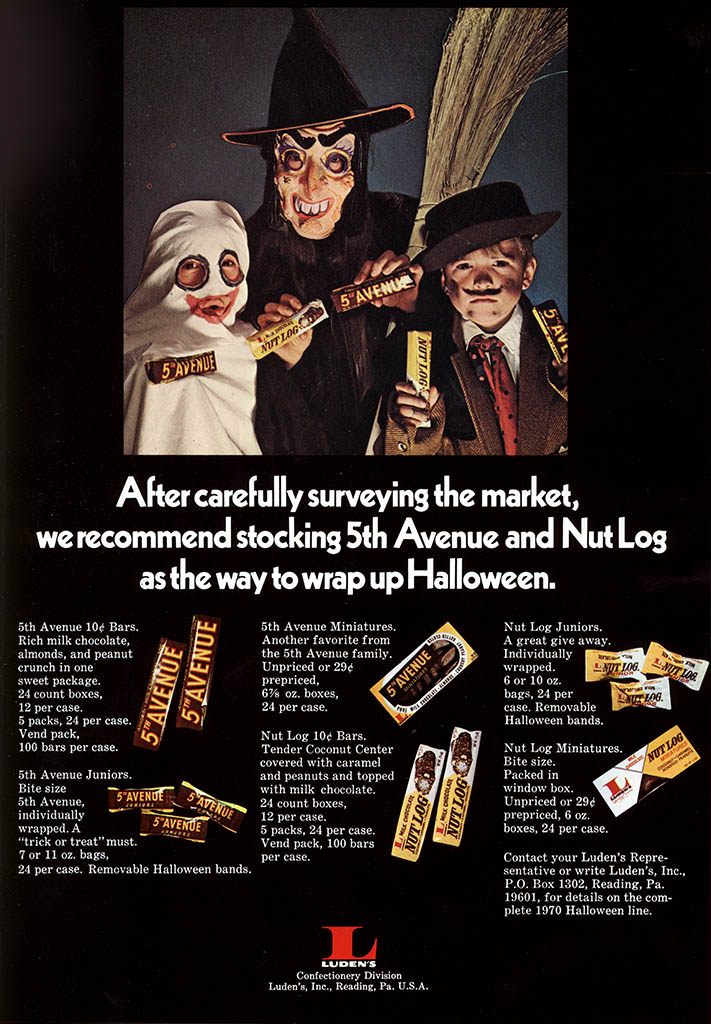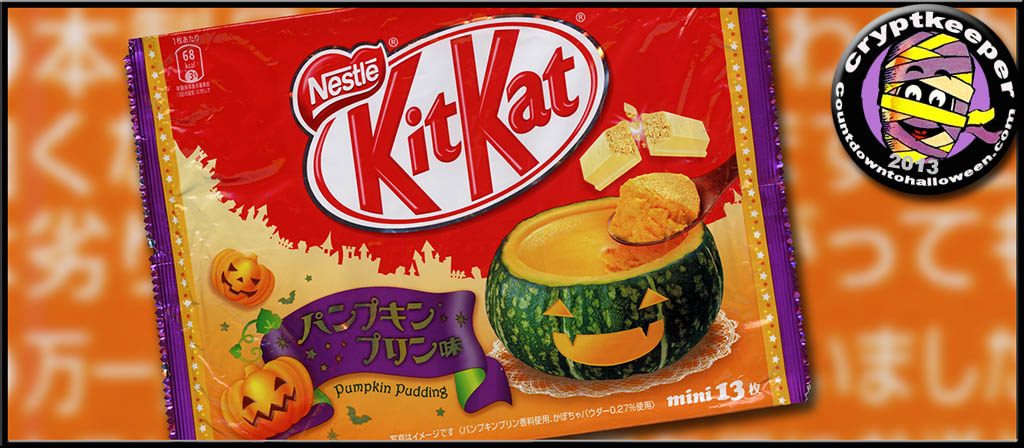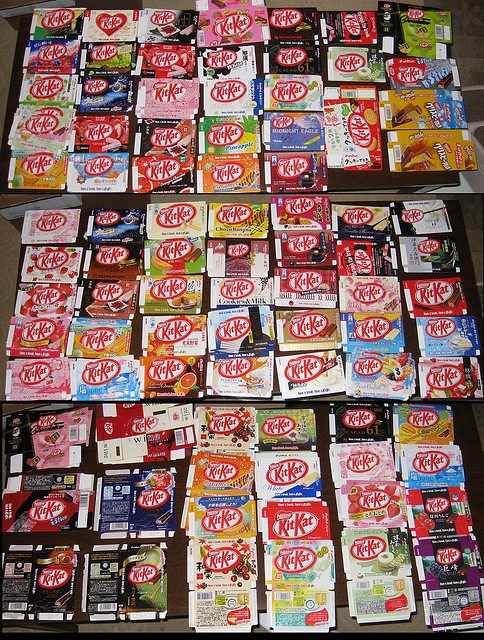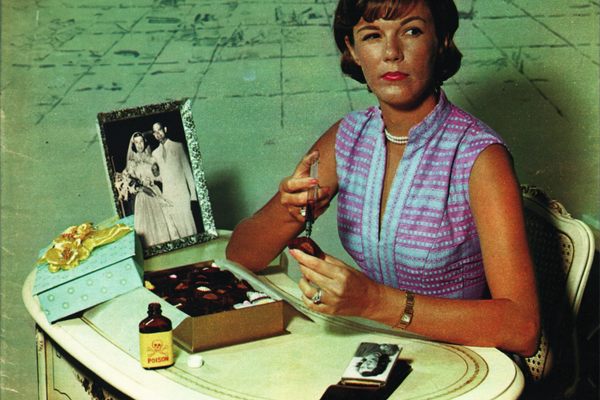The Sweet Halloween Archives of a Candy Historian

(Image: Jason Liebig/collectingcandy.com)
For New York candy collector Jason Liebig, peak sugar-hunting season begins in September when the back-to-school displays come down and the seasonal Halloween sweets spring up.
Peering through store aisles and scouring the shelves, Liebig stalks scores of retail outlets to seek out candy that is not yet catalogued in his archives. Once home, Liebig lays out the day’s discoveries, sometimes totaling 30 or 40 treats, “just to see how debaucherous it’s become.” One trip to a big retailer like Target would never suffice for finding all the new and limited-edition candy. Sometimes it takes weeks to track down an item.
Liebig, who is 46, stores his vast collection of confections (or, more specifically, their wrappers and packaging) at his apartment in Queens. As far as seasonal packaging goes, he says, Halloween takes the cake. He loves to see twists on classic brands; this year, he gives a nod of approval to the red nougat “3 Muskefears” and Mike and Ike Zours Zombies. On Liebig’s website, collectingcandy.com—part blog, part photo archive, part video vault—you can read hundreds of posts and watch over 500 videos about confections past and present.

Luden’s Halloween Candy Industry trade ad, July 1970. (Image: Jason Liebig/collectingcandy.com)
Many clever, kooky candy creations arrive every Halloween, and Liebig’s detailed archives work to commemorate them. Remember Necco’s mummy hearts? Perhaps you’ve tried some of Cadbury’s Screme Eggs, Halloween Ring Pops, XScream Snickers, Witchmallows, or, if you think back far enough, the 1948 Charms Halloween pops. Ever chew some 1960s Bazooka Halloween Mask Bubblegum Box or throw down a few Sour Patch Zombie Kids? How about Japan’s Pumpkin Pudding Halloween Kit Kats?

Yum! Japan’s pumpkin pudding Kit Kat, now recorded in the candy history books. (Image: Jason Liebig/collectingcandy.com)
Liebig is one of America’s premier candy experts—part collector, part archaeologist, part detective, part historian—and he now curates candy full time. He compares the volume of candy circulation to the fossil record, and his mission is to document each and every unique artifact. There’s a premium on first editions and historical relics, all of which undergo archival-level scans and are then uploaded to his gallery of over 3,200 images. His blog posts run almost daily, their titles all ending in exclamation points: Top-Ten Weirdest Flavors of Candies You Love! and The Pre-Hershey History of Kit Kat USA: Discovered and Uncovered!
“It doesn’t have the gravitas of the history of human rights,” says Liebig. “It’s more a fun part of our past, and it’s nice to know someone out here is capturing it. I’m trying to create this historical document of our shared consumer culture.” If there already existed a proper candy encyclopedia, Liebig would have done something else with his time. For him, it’s always been about finding the answers to questions and feeling the constant sense of discovery.

What sweets will sell best? Consult Brach’s 1971 Halloween Salesman Packet. (Image: Jason Liebig/collectingcandy.com)
And it turns out that there’s a lot to discover. Candy companies have never kept particularly careful records, it seems. For example, since no one at Nestle could remember what year Butterfinger was invented, in 2013 the company celebrated the candy’s “90ish” anniversary. Nestle once had to reference Liebig’s website because their records were incomplete. When he first began his candy collecting, Liebig found the confectionary record to be remarkably scarce—70 percent of the images on his site were things that were “ungoogle-able” before he documented them, and at one point, it took him three years of daily eBay searches to find a single Hot Tamales box.
Liebig was a collector of a lot of things growing up—baseball cards, Star Wars paraphernalia, comic books. All of that was entertaining, he says, but they left little to be discovered. While in his role as an editor at Marvel Comics, Liebig developed a keen appreciation for graphic design and later, while working as an actor in 2002, he discovered a picture book dedicated to vintage food graphics called Krazy Kid’s Food!, “like a Disneyland for the eyes,” he recalls. He started trying to find some of the book’s items, beginning mostly with cereal boxes, since candy packaging was hard to find.
Liebig then serendipitously stumbled across a fellow who had saved a whole suitcase of candy packaging. Seventy to 90 percent of its contents wasn’t searchable online, and Liebig acquired the collection and started a Flickr account to chart this frontier of undocumented pop material. “It was as if no one had copies of the Twilight Zone on tape, or had the only copies of Love Boat,” he says. “I felt like I had discovered this.”

Japan’s cornucopia of flavored Kit Kats. (Image: Jason Liebig/collectingcandy.com)
Some of his discoveries include Australia’s musk-flavored Lifesavers (“I always describe them as tasting like my grandmother’s makeup”), Willy Wonka’s discontinued Hot and Cool Nerds, and an abundance of vintage candy advertisements. There are just so many thousands of unknown things, says Liebig. “I know things that Nestle doesn’t know about Nerds, that Hershey’s doesn’t know about Milk Duds.”
Recently, Liebig has even served as a candy consultant for several TV shows, notably Mad Men and The Goldbergs, which take place in the 1960s and 1980s. Liebig gives guidance on confectionary props and packaging for the time period; he’ll go into his physical and digital archives and try to find as much iconic packaging as he can, and then give the show a selection from which they can choose. Seeing his candy in The Goldbergs’ recent Halloween episode, he says, was like seeing a friend on TV.

Witchmallows from the 1950s. (Image: Jason Liebig/collectingcandy.com)
Liebig considers his work a legitimate, historical pursuit. It is in many respects still a hobby, he says, but he’s trying to transition it to more of a profession. He launched his website to bring some editorial continuity to his candy curation and to write about his discoveries. He’s hoping at some point to turn it into a book, though right now, he’s focused on a Kickstarter campaign for his own novelty candy: Zombie Mouth Bubble Gum. The gum, motivated by his “geeky origins” and inspired by a Darth Vader cake loaded with black dye from his 11th birthday, will turn your mouth black and purple.
When asked the best candies to hand out on Halloween, Liebig keeps it simple: Snickers (America’s most popular for years), Skittles (the number one non-chocolate confection since the late ’70s), some Reese’s peanut butter cups (of course) and Brach’s candy corn (he likes it, anyway).
Being a leader in candy history and keeping more accurate and extensive records than many candy companies themselves has become a bigger job than Liebig ever anticipated. On store shelves across the world all year, but especially leading up to Halloween, an abundance of confectionary history is being made, sold, and eaten. Luckily for us, Liebig will ensure that every new item finds a home in his archives. Our collective candy consciousness is in safe hands.
Gastro Obscura covers the world’s most wondrous food and drink.
Sign up for our email, delivered twice a week.
















Follow us on Twitter to get the latest on the world's hidden wonders.
Like us on Facebook to get the latest on the world's hidden wonders.
Follow us on Twitter Like us on Facebook